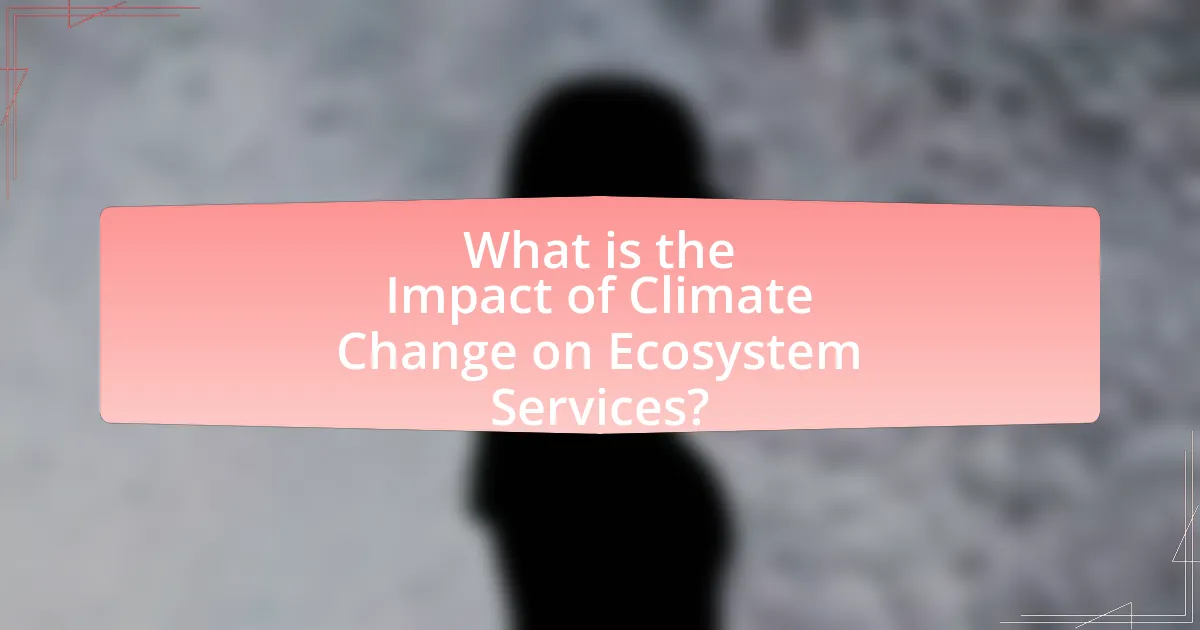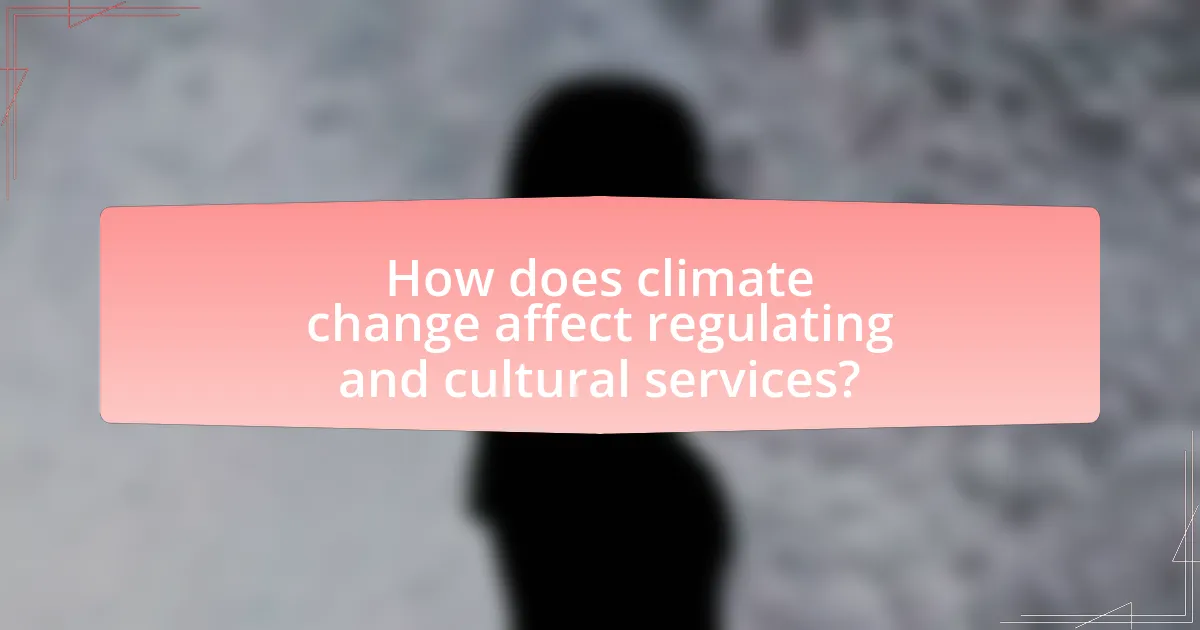Climate change significantly impacts ecosystem services, which are essential benefits that humans derive from natural environments. This article examines how climate change disrupts various types of ecosystem services, including provisioning, regulating, cultural, and supporting services, leading to reduced biodiversity, altered species distributions, and diminished ecosystem functionality. Key findings indicate that climate change could decrease global agricultural yields by up to 30% by 2050, threaten food security, and exacerbate natural disasters. Additionally, the article highlights the implications for biodiversity, human well-being, and the importance of implementing conservation and sustainable practices to mitigate these effects.

What is the Impact of Climate Change on Ecosystem Services?
Climate change significantly disrupts ecosystem services, which are the benefits humans derive from natural environments. These disruptions manifest through altered species distributions, reduced biodiversity, and changes in ecosystem functions such as pollination, water purification, and carbon sequestration. For instance, a study published in “Nature Climate Change” by IPCC in 2021 indicates that climate change could lead to a decline in global agricultural yields by up to 30% by 2050, directly impacting food security and livelihoods. Additionally, rising temperatures and shifting precipitation patterns can exacerbate the frequency and intensity of natural disasters, further diminishing the resilience of ecosystems and their ability to provide essential services.
How does climate change affect the various types of ecosystem services?
Climate change negatively impacts various types of ecosystem services by altering their functionality and availability. For instance, changes in temperature and precipitation patterns disrupt the provisioning services, such as food and water supply, leading to reduced agricultural yields and water scarcity. Additionally, climate change affects regulating services, including carbon sequestration and flood control, as ecosystems like forests and wetlands become less effective due to increased stressors like droughts and wildfires. Furthermore, climate change threatens cultural services, such as recreational and aesthetic values, as shifting ecosystems may diminish biodiversity and alter landscapes. Research indicates that these changes can lead to significant economic losses; for example, the Intergovernmental Panel on Climate Change (IPCC) reports that climate change could reduce global agricultural productivity by up to 30% by 2050, directly affecting food security and livelihoods.
What are the key categories of ecosystem services impacted by climate change?
The key categories of ecosystem services impacted by climate change include provisioning services, regulating services, cultural services, and supporting services. Provisioning services, such as food and water supply, are affected by altered weather patterns and resource availability. Regulating services, which include climate regulation and flood control, are disrupted due to changes in temperature and precipitation. Cultural services, encompassing recreational and spiritual benefits, are influenced by shifts in biodiversity and ecosystem health. Supporting services, like nutrient cycling and soil formation, are compromised as ecosystems face stress from climate change. These impacts are documented in studies, such as the Intergovernmental Panel on Climate Change reports, which highlight the extensive effects of climate change on ecosystem functionality and human well-being.
How do changes in temperature and precipitation influence ecosystem services?
Changes in temperature and precipitation significantly influence ecosystem services by altering species composition, productivity, and the availability of resources. For instance, increased temperatures can lead to shifts in plant and animal distributions, affecting pollination and food production services. Additionally, altered precipitation patterns can impact water availability, influencing freshwater supply and agricultural productivity. Research indicates that a 1°C rise in temperature could reduce crop yields by up to 10% in some regions, while changes in rainfall patterns can exacerbate droughts or flooding, further stressing ecosystems. These shifts can disrupt the balance of ecosystem functions, ultimately affecting human well-being and biodiversity.
Why is understanding the impact of climate change on ecosystem services important?
Understanding the impact of climate change on ecosystem services is crucial because these services are essential for human well-being and environmental health. Ecosystem services, such as pollination, water purification, and carbon sequestration, directly support food production, clean water access, and climate regulation. Research indicates that climate change can disrupt these services, leading to decreased agricultural yields and increased vulnerability to natural disasters. For instance, a study published in the journal “Nature” found that shifts in climate patterns could reduce global crop yields by up to 25% by 2050, highlighting the urgent need to understand these impacts for effective policy and management strategies.
What are the implications for biodiversity and species survival?
Climate change significantly threatens biodiversity and species survival by altering habitats, disrupting ecosystems, and increasing extinction rates. Rising temperatures and changing precipitation patterns lead to habitat loss, as species struggle to adapt to new environmental conditions. For instance, a study published in “Nature” by Thomas et al. (2004) projected that up to 30% of species could face an increased risk of extinction if global temperatures rise by 2°C. Additionally, climate change affects species interactions, such as predator-prey dynamics and competition for resources, further destabilizing ecosystems. These changes can result in reduced genetic diversity, making species more vulnerable to diseases and environmental changes, ultimately jeopardizing their survival.
How does the degradation of ecosystem services affect human well-being?
The degradation of ecosystem services negatively impacts human well-being by reducing the availability of essential resources such as clean water, food, and air quality. For instance, the loss of biodiversity and habitat destruction can lead to diminished agricultural productivity, which directly affects food security. According to the Intergovernmental Science-Policy Platform on Biodiversity and Ecosystem Services (IPBES), approximately 1 million species are at risk of extinction, which threatens the ecosystems that provide vital services. Furthermore, degraded ecosystems can exacerbate health issues by increasing pollution and reducing access to natural spaces that promote mental and physical health. Thus, the decline in ecosystem services directly correlates with increased vulnerability and decreased quality of life for human populations.

What are the specific effects of climate change on provisioning services?
Climate change significantly affects provisioning services by altering food production, water supply, and raw materials availability. Increased temperatures and changing precipitation patterns can lead to reduced agricultural yields, as evidenced by a study from the Intergovernmental Panel on Climate Change, which projects that global crop yields could decline by up to 25% by 2050 due to climate impacts. Additionally, climate change can disrupt freshwater availability, with altered hydrological cycles leading to both droughts and floods, impacting water supply for irrigation and drinking. Furthermore, shifts in ecosystems can affect the availability of natural resources, such as timber and fish, as species migrate or decline in response to changing environmental conditions.
How does climate change influence food production and security?
Climate change significantly influences food production and security by altering agricultural conditions, leading to reduced crop yields and increased food scarcity. Rising temperatures, changing precipitation patterns, and extreme weather events negatively impact soil health, water availability, and pest dynamics, which are critical for sustainable agriculture. For instance, the Intergovernmental Panel on Climate Change (IPCC) reports that global crop yields could decline by up to 25% by 2050 due to climate-related factors. Additionally, food security is threatened as vulnerable populations face heightened risks of malnutrition and food shortages, particularly in regions already experiencing economic instability.
What are the effects on crop yields and livestock health?
Climate change negatively affects crop yields and livestock health. Rising temperatures, altered precipitation patterns, and increased frequency of extreme weather events lead to reduced agricultural productivity. For instance, a study published in “Nature Climate Change” by Lobell et al. (2011) found that climate change could reduce global crop yields by up to 25% by 2050. Additionally, livestock health suffers due to heat stress, reduced forage availability, and increased disease prevalence, as highlighted in research from the Food and Agriculture Organization (FAO), which indicates that climate change could lead to a decline in livestock productivity by 10-30% in vulnerable regions.
How do changing weather patterns affect fisheries and aquaculture?
Changing weather patterns significantly impact fisheries and aquaculture by altering water temperatures, salinity, and oxygen levels, which can affect fish populations and their habitats. For instance, warmer water temperatures can lead to shifts in species distribution, as many fish species migrate to cooler areas, potentially reducing catch rates in traditional fishing zones. Additionally, increased frequency of extreme weather events, such as storms and flooding, can damage aquaculture infrastructure and disrupt fish farming operations. Research indicates that climate change could reduce global fishery yields by 20% by 2050, highlighting the vulnerability of these industries to changing climatic conditions.
What are the impacts on water supply and quality due to climate change?
Climate change significantly impacts water supply and quality by altering precipitation patterns, increasing evaporation rates, and exacerbating pollution. These changes lead to reduced freshwater availability in many regions, with studies indicating that by 2050, up to 1.8 billion people may face water scarcity due to climate-related factors. Additionally, higher temperatures and extreme weather events can lead to increased runoff, which carries pollutants into water bodies, degrading water quality. For instance, the U.S. Environmental Protection Agency reports that climate change can intensify harmful algal blooms, further compromising drinking water sources.
How does climate change affect freshwater availability?
Climate change significantly reduces freshwater availability by altering precipitation patterns and increasing evaporation rates. As global temperatures rise, regions experience more intense droughts and irregular rainfall, leading to decreased surface water and groundwater recharge. For instance, the Intergovernmental Panel on Climate Change (IPCC) reports that many areas, particularly in arid and semi-arid regions, will face a decline in water resources due to these changes. Additionally, increased evaporation from lakes and rivers exacerbates water scarcity, further impacting ecosystems and human water supply.
What are the consequences for water quality and ecosystem health?
Climate change significantly deteriorates water quality and ecosystem health. Increased temperatures and altered precipitation patterns lead to higher nutrient runoff, resulting in eutrophication, which depletes oxygen levels in water bodies and harms aquatic life. For instance, a study published in the journal “Environmental Science & Technology” found that nutrient loading from agricultural runoff has increased by 30% in some regions due to climate change, leading to harmful algal blooms that threaten fish populations and drinking water sources. Additionally, rising water temperatures can disrupt species composition and migration patterns, further destabilizing ecosystems.

How does climate change affect regulating and cultural services?
Climate change negatively impacts regulating and cultural services by disrupting ecosystem balance and diminishing biodiversity. Regulating services, such as climate regulation, water purification, and disease control, are compromised as altered weather patterns lead to increased flooding, droughts, and habitat loss. For instance, the Intergovernmental Panel on Climate Change (IPCC) reports that rising temperatures and changing precipitation patterns can exacerbate water scarcity and reduce the ability of ecosystems to filter pollutants effectively.
Cultural services, which encompass recreational, aesthetic, and spiritual benefits derived from nature, are also affected as climate change alters landscapes and reduces access to natural areas. A study published in “Global Environmental Change” by Chan et al. (2016) highlights that shifts in species distributions and the degradation of natural habitats can diminish opportunities for outdoor activities and cultural practices tied to specific ecosystems. Thus, climate change poses significant threats to both regulating and cultural services, undermining the essential functions that ecosystems provide to human well-being.
What are the impacts on climate regulation and carbon sequestration?
Climate regulation and carbon sequestration are significantly impacted by ecosystem health and biodiversity. Healthy ecosystems, such as forests, wetlands, and grasslands, enhance carbon storage by absorbing carbon dioxide from the atmosphere through photosynthesis. For instance, forests alone sequester approximately 2.6 billion metric tons of carbon annually, which is crucial for mitigating climate change. Conversely, climate change disrupts these ecosystems, leading to reduced biodiversity and increased carbon emissions from soil and vegetation. Research indicates that deforestation and land-use changes can release up to 1.1 billion metric tons of carbon dioxide per year, exacerbating global warming. Thus, the interplay between ecosystem integrity and climate regulation is vital for effective carbon sequestration.
How do forests and wetlands contribute to climate regulation?
Forests and wetlands significantly contribute to climate regulation by sequestering carbon dioxide and maintaining local and global climate stability. Forests act as carbon sinks, absorbing approximately 2.6 billion metric tons of carbon annually, which helps mitigate the greenhouse effect. Wetlands, on the other hand, store carbon in their biomass and soil, with peatlands alone holding about 30% of the world’s soil carbon despite covering only 3% of the land surface. Additionally, both ecosystems regulate temperature and precipitation patterns, influencing weather systems and reducing the impacts of climate extremes.
What role do ecosystem services play in mitigating climate change effects?
Ecosystem services play a crucial role in mitigating climate change effects by providing natural processes that regulate greenhouse gases and enhance resilience. For instance, forests sequester carbon dioxide, with global forests absorbing approximately 2.6 billion metric tons of CO2 annually, which helps reduce atmospheric concentrations of this greenhouse gas. Additionally, wetlands act as natural buffers against flooding and storm surges, thereby protecting coastal areas from climate-related disasters. These services not only help in carbon storage but also support biodiversity, which is essential for ecosystem stability and adaptability in the face of climate change.
How does climate change influence cultural services and recreational opportunities?
Climate change significantly influences cultural services and recreational opportunities by altering ecosystems and the availability of natural resources. As temperatures rise and weather patterns shift, many outdoor recreational activities, such as hiking, fishing, and skiing, are affected; for instance, reduced snowpack limits winter sports and changes in water temperatures impact fish populations, thereby diminishing fishing opportunities. Additionally, climate change can lead to the loss of biodiversity, which diminishes the cultural significance of natural landscapes and traditional practices tied to specific ecosystems. Research indicates that areas experiencing severe climate impacts, such as coastal regions facing rising sea levels, see a decline in tourism and recreational activities, further affecting local economies reliant on these cultural services.
What are the effects on tourism and outdoor activities?
Climate change significantly affects tourism and outdoor activities by altering natural landscapes and ecosystems. For instance, rising temperatures can lead to diminished snow cover in ski resorts, resulting in reduced visitor numbers and economic losses for local communities dependent on winter sports. Additionally, increased frequency of extreme weather events, such as hurricanes and floods, can disrupt travel plans and damage infrastructure, further deterring tourists. According to a study by the Intergovernmental Panel on Climate Change, climate change could reduce global tourism revenues by up to 20% by 2100 if current trends continue. This evidence underscores the direct correlation between climate change impacts and the viability of tourism and outdoor recreational activities.
How does the loss of biodiversity impact cultural heritage and identity?
The loss of biodiversity significantly impacts cultural heritage and identity by eroding the traditional practices, beliefs, and knowledge systems that are closely tied to specific ecosystems. Indigenous communities, for example, often rely on local flora and fauna for their cultural rituals, medicinal practices, and food sources; when these species decline, the cultural practices associated with them also diminish. A study by the United Nations Educational, Scientific and Cultural Organization (UNESCO) highlights that biodiversity loss can lead to the disappearance of traditional ecological knowledge, which is vital for cultural identity and community cohesion. Furthermore, the extinction of species can disrupt the narratives and symbols that shape a community’s identity, as seen in various cultures where specific animals or plants hold significant spiritual or historical meaning.
What strategies can be implemented to mitigate the impact of climate change on ecosystem services?
To mitigate the impact of climate change on ecosystem services, strategies such as enhancing biodiversity, restoring degraded ecosystems, and implementing sustainable land management practices can be employed. Enhancing biodiversity increases ecosystem resilience, allowing systems to better withstand climate stressors; for instance, diverse plant species can improve soil health and water retention. Restoring degraded ecosystems, such as wetlands and forests, can improve carbon sequestration and water filtration, which are critical for maintaining ecosystem services. Sustainable land management practices, including agroecology and conservation agriculture, reduce greenhouse gas emissions and promote soil health, thereby supporting ecosystem functions. These strategies are supported by research indicating that biodiversity loss and ecosystem degradation significantly impair the ability of ecosystems to provide essential services, as highlighted in the Intergovernmental Science-Policy Platform on Biodiversity and Ecosystem Services (IPBES) reports.
What role do conservation and restoration efforts play?
Conservation and restoration efforts play a critical role in mitigating the impacts of climate change on ecosystem services. These efforts help preserve biodiversity, maintain ecosystem functions, and enhance resilience against climate-related disturbances. For instance, restoring wetlands can improve water quality and flood regulation, while conserving forests can sequester carbon, thus reducing greenhouse gas concentrations in the atmosphere. According to the Intergovernmental Panel on Climate Change (IPCC), effective conservation strategies can significantly enhance ecosystem resilience, which is essential for sustaining the services that ecosystems provide to humanity, such as clean air, water, and food security.
How can sustainable practices enhance ecosystem resilience?
Sustainable practices enhance ecosystem resilience by promoting biodiversity, improving soil health, and reducing pollution. Biodiversity increases the variety of species within an ecosystem, which can lead to greater stability and adaptability in the face of environmental changes. For instance, diverse ecosystems are better equipped to recover from disturbances such as droughts or floods. Improved soil health, achieved through practices like crop rotation and organic farming, enhances nutrient cycling and water retention, making ecosystems more robust against climate variability. Additionally, reducing pollution through sustainable waste management and renewable energy sources minimizes harmful impacts on ecosystems, allowing them to function more effectively. Research indicates that ecosystems with higher biodiversity can recover more quickly from stressors, demonstrating the critical role of sustainable practices in fostering resilience.


